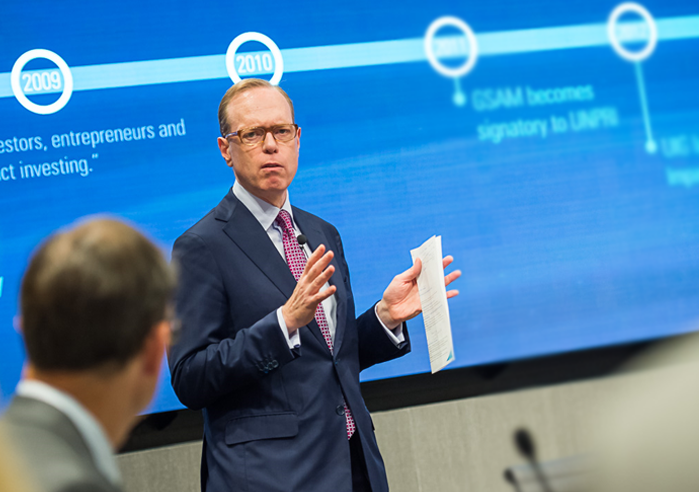ImpactAlpha, June 5 – A changing climate is changing the climate inside one of the world’s largest asset managers.
Clients of Goldman Sachs Assets Management, which manages assets on behalf of wealthy families, pensions and foundations, endowments and insurance companies, have always expected the firm to recite key financial metrics about the companies they own.
All of those metrics continue to be important.
But increasingly, says Hugh Lawson, the head of ESG and impact investing at Goldman, clients are demanding the big Wall Street money manager know more about the qualitative aspects of what those businesses do and how they do it.
In the latest episode of ImpactAlpha’s Returns on Investment podcast, David Bank digs in with Lawson about how greater investor urgency around climate, and growing confidence in low-carbon investment strategies, is changing asset management, or isn’t.
The big Wall Street money manager now manages a $21 billion client pool of money invested explicitly with environmental, social and governance, or impact, objectives. An ESG and impact allocation in the tens of billions seems like a lot until you consider that Goldman Sachs Asset Management advises about $1.7 trillion in assets.
Still, Lawson says awareness of climate, and other ESG-related issues, is taking hold amongst the firm’s money managers. “In the world in which we live today there’s a great recognition of the interdependencies between all of those things and financial performance,” he says.
And so Goldman is ramping up its ESG and impact capacities. One of its early moves was the 2015 acquisition of San Francisco-based Imprint Capital, which had carved our an early position as a research-driven impact manager with a high degree of investment acumen. Internally, it mobilized and amplified talent that had been plugging away independently at environmental and other related issues.
“The intensity of focus and depth of data and information an active manager wants to appropriately assess these ESG factors, that’s going up,” says Lawson. “Over time.. you will see this become quite a standard thing among active managers.”
Investing question
Lawson is a 23-year investment veteran. But it was a stint as investment committee chair five years ago at Rockefeller Brothers Fund, the $1.1 billion New York philanthropy of the five third-generation Rockefeller brothers, that woke him to ESG and impact.
The Rockefeller heirs, who owed their fortune to 19th century petroleum company Standard Oil, had decided to divest their endowment from fossil fuels, and shift capital into pro-environment impact investments. But the brothers also wanted to keep their returns, to maintain their foundation’s grant budget.
“It stuck me fundamentally as an investing question like any other,” says Lawson.
Like other investments, climate-related impact investments happen in a world of uncertainty. Also like other investments, there’s generally more than one right answer for how capital can be invested prudently. Lawson looked across public and private markets, considered the objectives and time horizon of the foundation, assessed what level of risk was both necessary and tolerable.
“What I thought was so interesting about it was, you are integrating these ESG and impact objectives into all of the other investing questions you are attacking simultaneously,” he says.
In the five years since, Rockefeller Brother Fund has nearly completely divested from businesses that extract and process fossil fuels, and shifted 10% of its endowment to impact strategies in private markets.
Rockefeller Brothers Fund: How the Oil Heirs Are Getting Out of Fossil Fuels
Drip, drip, drip
What is different about ESG and impact strategies, says Lawson, is the rigorous focus on what the enterprise is doing and how it is doing it.
In addition to price-earnings multiples, dividend yields and credit ratings, ESG and impact analysis includes attention to qualitative dimensions, such as labor, key stakeholders, supply chains, environmental impact of the business, emissions and other externalities.
“Almost all investment strategies have a heightened awareness of these factors,” says Lawson. The questions then become, ‘how do you weight them” and “what views do you want to take around them?” That process, says Lawson, “is the same process that any active manager is doing.”
Goldman has worked with the $210 billion New York State Common Retirement Fund to develop a low-carbon index fund. The index exhibits the same expected return and risk characteristics, as their purely market cap-based equity implementation does. But it tilts capital a degree toward companies efficient in generating shareholder value, but per unit of emissions.
Still, even with all the attention the pension fund is giving low-carbon investing, it has allocated less than 2% of its portfolio to the index.
“ESG and impact investing can be rigorously done and additive to a portfolio in the same way that there are other themes that one may focus on that can be additive,” says Lawson.
New York State pension fund to energy cos: How will you adapt to low-carbon future?
At big pension funds, and big money managers like Goldman, urgency around climate change, and even confidence in low-carbon investment strategies, have yet to trigger large shifts in strategy, and capital.
“It’s a journey,” says Lawson. “It would be unusual in the investing world on one day to manage your assets in one way, and then on the next day manage all of them somewhat differently. It tends to be a process.”











